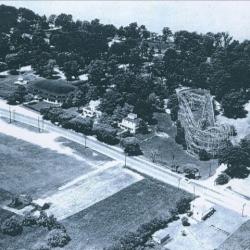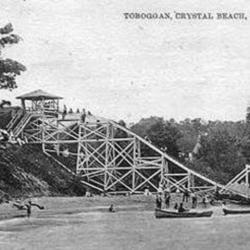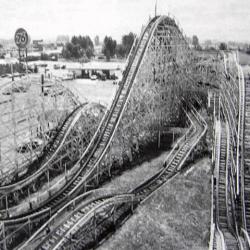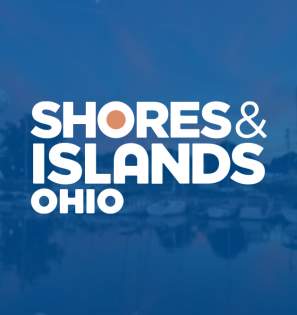Part of our Time Traveler Series
 Shores & Islands Ohio has a century-and-a-half-long history of providing the ying-yang of both thrills and relaxation to vacationers. Dating back to 1870, Cedar Point Amusement Park, also known as the Roller Coaster Capital of the World, currently holds the title of the second-oldest amusement park in the country. While most thrill seekers are familiar with Cedar Point, there was another area park which also opened in the 1870s. Known by the monikers Little Monte Carlo and the Park of a Thousand Trees, the origins of Crystal Beach Park date back to the 1870s when George Shadduck converted 22.5 acres of his Vermilion lakefront farm into a tree-canopied picnic grove, bathing beach, beer garden, and dance hall.
Shores & Islands Ohio has a century-and-a-half-long history of providing the ying-yang of both thrills and relaxation to vacationers. Dating back to 1870, Cedar Point Amusement Park, also known as the Roller Coaster Capital of the World, currently holds the title of the second-oldest amusement park in the country. While most thrill seekers are familiar with Cedar Point, there was another area park which also opened in the 1870s. Known by the monikers Little Monte Carlo and the Park of a Thousand Trees, the origins of Crystal Beach Park date back to the 1870s when George Shadduck converted 22.5 acres of his Vermilion lakefront farm into a tree-canopied picnic grove, bathing beach, beer garden, and dance hall.
Originally known as Shadduck’s Grove, the house located on the property was a popular stagecoach inn and stop for travelers between Cleveland and Toledo due to the beautiful Lake Erie views and delicious meals. Early appeals also included lush tree cover, providing cool shade, and convenient horse-drawn buggy access. With the addition of games (such as a roulette wheel and shooting gallery) and a carousel, in the late 1890s, the grove began to take shape as an amusement park.
 In the year 1906, Mr. Shadduck passed away and his wife and children had no interest in operating the grove. In 1907, it was sold to businessman, George Blanchat and his wife, Josephine. Josephine renamed the park Crystal Beach Park after the sparkling sand found on the beach. The Blanchat Family added concessions, attractions, and additional rides to the park’s inventory. Picnic shelters and parking lots that would hold up to 5,000 automobiles were also constructed.
In the year 1906, Mr. Shadduck passed away and his wife and children had no interest in operating the grove. In 1907, it was sold to businessman, George Blanchat and his wife, Josephine. Josephine renamed the park Crystal Beach Park after the sparkling sand found on the beach. The Blanchat Family added concessions, attractions, and additional rides to the park’s inventory. Picnic shelters and parking lots that would hold up to 5,000 automobiles were also constructed.
Vermilion is located along U.S. Route 6 roughly 37 miles from Cleveland and 75 miles from Toledo, making this lakeside town an easily-accessible destination for those looking to escape the business and pollution of the city. In addition to cars, Crystal Beach Park was conveniently reached by the Lake Shore Electric Railway (LSE), an east-west traveling interurban that transported riders between Cleveland and Toledo via Lorain, Sandusky, Norwalk, and Fremont. The LSE boosted tourism along Ohio’s northern coast, as it was an integral dynamic in the establishment and development of many recreational areas and resorts along the Lake Erie shoreline. The interurban’s Crystal Beach Station was stop number 128 and was located approximately .5 miles south of the park, just east of Vermilion Road and north of the New York Central railroad tracks (currently Norfolk Southern).
 Business was growing and through 1918, the park experienced an expansion. An arcade, bath house, bandstand, playground, boat rentals, cottages, several dining options, box-ball and bowling alleys, along with a lake toboggan were added. Crystal Beach had it all; even its own baseball team!
Business was growing and through 1918, the park experienced an expansion. An arcade, bath house, bandstand, playground, boat rentals, cottages, several dining options, box-ball and bowling alleys, along with a lake toboggan were added. Crystal Beach had it all; even its own baseball team!
The 1920s and 1930s were known as the “golden years” for the park. The crown jewel was Crystal Gardens, a beautiful new ballroom that opened in 1925. Admission to the ballroom was ten cents and a dance was five cents each. Guests came in droves to listen to the big bands of the era and to dance the night away. Many of the advertisements for the bands were printed locally at The Vermilion News, which is now a museum. The Vermilion History Museum has some of the handbills, tickets, and posters for Crystal Beach on display.
The 1920s also saw the addition of the park’s first and only roller coaster. Built in 1926, the Thriller was a 61-foot-tall coaster and was considered the “safest” of its day. Through the 1950s, the park witnessed the expansion of attractions, including 28 concession stands, 15 feature rides, seven kiddie rides, a fun house, pony rides, ball fields, mini golf, 15 rental cottages, and more.
 Crystal Beach did endure its share of hardships. The Wagner Act of 1935 banned companies from having their own unions. This ban resulted in employers holding fewer company picnics, which was the bread-and-butter for the park. With this revenue source decreasing, the park’s bottom line became negatively impacted. In 1938, the LSE interurban railway ceased operation (six years after declaring bankruptcy). Cedar Point, which also benefited tremendously from the LSE, still provided transportation from Cleveland, Detroit, and Toledo by way of steamship. Crystal Beach Park did not have that option as there were no facilities at the park to accommodate large passenger ships. A devastating fire swept through the park in April of 1947. The fire raged for several hours and destroyed the ballroom, lakefront arcade, skeeball, casino, roller rink, lakefront pavilion, park warehouse, several shade trees, and damaged several nearby houses; all resulting in $150,000 total damage.
Crystal Beach did endure its share of hardships. The Wagner Act of 1935 banned companies from having their own unions. This ban resulted in employers holding fewer company picnics, which was the bread-and-butter for the park. With this revenue source decreasing, the park’s bottom line became negatively impacted. In 1938, the LSE interurban railway ceased operation (six years after declaring bankruptcy). Cedar Point, which also benefited tremendously from the LSE, still provided transportation from Cleveland, Detroit, and Toledo by way of steamship. Crystal Beach Park did not have that option as there were no facilities at the park to accommodate large passenger ships. A devastating fire swept through the park in April of 1947. The fire raged for several hours and destroyed the ballroom, lakefront arcade, skeeball, casino, roller rink, lakefront pavilion, park warehouse, several shade trees, and damaged several nearby houses; all resulting in $150,000 total damage.
Crystal Beach replaced some of these structures with more modern, steel buildings, but as the 1950s approached, this family-owned park found it challenging to compete with larger, corporate-owned parks. The unpredictable weather conditions of northern Ohio also played a factor in generating revenue. A rainy day meant no profits coming in. Company picnics were becoming less popular. There was less of a need for vacation cottage rentals as Vermilion and surrounding areas were becoming permanent residences for people, and less of a transient destination. Big bands and dancing were losing popularity. The construction of the State Route 2 divided highway diverted traffic around Vermilion and in turn, Crystal Beach.
 A portion of the park’s property (20 acres), just south of U.S. 6, was sold in 1959 to the developers of South Shore Shopping Center. An additional 20 acres of the eastern side was sold in 1961 for a hotel. And in 1962, the remaining Crystal Beach property was sold to a development corporation. The concessions and rides, including the Thriller coaster, were dismantled and sold. Some rides went to other parks and others were scrapped. After the sale, the only structure remaining was the ballroom, which became a roller rink, then razed a few years later.
A portion of the park’s property (20 acres), just south of U.S. 6, was sold in 1959 to the developers of South Shore Shopping Center. An additional 20 acres of the eastern side was sold in 1961 for a hotel. And in 1962, the remaining Crystal Beach property was sold to a development corporation. The concessions and rides, including the Thriller coaster, were dismantled and sold. Some rides went to other parks and others were scrapped. After the sale, the only structure remaining was the ballroom, which became a roller rink, then razed a few years later.
Today, a shopping center sits on the 20 southern acres, houses and apartments are where the rides and attractions were, and a bank sits on the site of the ballroom/roller rink. Near the site is a 5x8 foot mural of the ballroom, part of the Vermilion Postcard Project.
Source: Memories of Crystal Beach Park, Vermilion, Ohio by Sandra Calvert Muller, Marlene Calvert Feldkamp, and Tom Ryan. Photos provided by vermilionohio.org, Lorain County Life, and Vermilion Historical Society.



